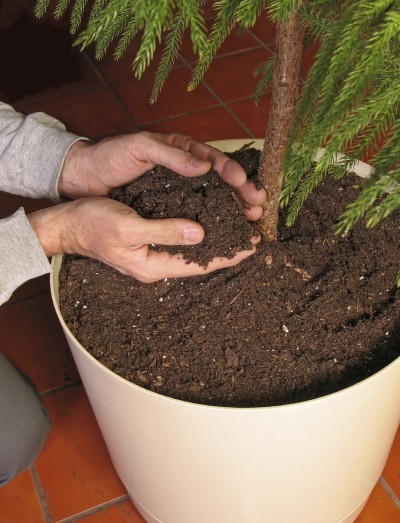






Basically all houseplants need repotting every now and again. This may be because the plant’s roots have grown too large for their container, or because all the nutrients in the potting soil have been used up. Either way, if your plant seems to be languishing or wilting soon after watering, it might be time for a repotting, even if the plant is large. Keep reading for more information on how and when to repot tall plants.
Repotting a large plant can be daunting, but it is necessary. Some overgrown container plants, of course, are simply too big to move to a new pot. If this is the case, you should still refresh the soil by replacing the top two or three inches (3-7 cm.) once every year. This process is called top dressing, and it replenishes the nutrients in a pot without disturbing the roots.
If it’s feasible to move it to a larger pot, however, you should. The best time to do this is the spring, though it’s possible any time of year. You should avoid replanting large plants that are actively budding or blooming, however.
Now that you know when to repot tall plants, you need to know how.
The day before you plan to move the plant, water it – damp soil holds together better. Choose a container that’s 1-2 inches (2.5-5 cm.) larger in diameter than your current one. In a bucket, mix together more potting mix than you think you will need with an equal amount of water.
Turn your plant on its side and see if you can slide it out of its pot. If it sticks, try running a knife around the edge of the pot, pushing through the drainage holes with a pencil, or tugging gently on the stem. If any roots are growing out of the drainage holes, cut them away. If your plant is truly stuck, you may have to destroy the pot, cutting it with shears if it’s plastic or smashing it with a hammer if it’s clay.
Put enough of your moistened soil in the bottom of the new container that the top of the root ball will be about 1 inch (2.5 cm.) below the rim. Some people recommend putting stones or similar material in the bottom to aid in drainage. This doesn’t help as much with drainage as you’d think, though, and when transplanting overgrown container plants, it takes up precious space that should devoted to soil.
Loosen the roots in your root ball and discard the soil that comes loose – it probably contains more harmful salts than nutrients by now anyway. Cut away any roots that are dead or completely circling the root ball. Set your plant in the new container and surround it with moistened potting mix. Water thoroughly and keep it out of direct sun for two weeks.
And that’s it. Now care for the plant as usual.
Copyright © www.100flowers.win Botanic Garden All Rights Reserved